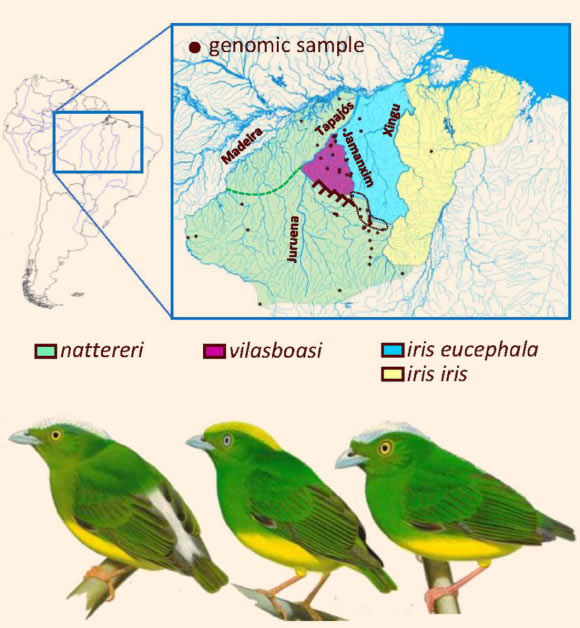An international team of ornithologists has revealed that a rare Amazonian bird called the golden-crowned manakin (Lepidothrix vilasboasi) — first discovered in Brazil in 1957 but not seen again until 2002 — is in fact a hybrid of two parental species: the snow-capped (Lepidothrix nattereri) and opal-crowned (Lepidothrix iris) manakins. This hybrid has a unique golden-colored crown patch used for display, which differs from the brilliant white coloration of the parental species.

The three species of manakins distributed east of the Madeira River in Amazonia (from left to right): the snow-capped (Lepidothrix nattereri), golden-crowned (Lepidothrix vilasboasi) and opal-crowned (Lepidothrix iris) manakins. Image credit: Barrera-Guzmán et al, doi: 10.1073/pnas.1717319115.
“While hybrid plant species are very common, hybrid species among vertebrates are exceedingly rare,” said Dr. Jason Weir, a researcher at the University of Toronto and senior author of a paper published in the Proceedings of the National Academy of Sciences.
“A hybrid species forms when two parental species mate to produce a hybrid population, which then stops being able to freely interbreed with the parental species.”
“In this case the two parents are the snow-capped manakin, named for its bright snowy-white crown feathers, and the opal-crowned manakin, named for its brilliant iridescent crown feathers.”
Dr. Weir and co-authors gathered genetic and feather samples over two separate field trips to Brazil.
The researchers were then able to sequence a large portion of the golden-crowned manakin’s genome including 16,000 different genetic markers, finding that about 20% of its genome came from the snowy-crowned, and about 80% came from the opal-crowned.
They also used something called coalescent modeling to figure out at what point the golden-crowned split off from its parental species.
“It was around 180,000 years ago when the two parental species originally mated, and that both parental species diverged from a common ancestor about 300,000 years ago, making all three very recent birds by Amazon rainforest standards,” the scientists explained.
“Most Amazon bird species diverged from their most recent relative around 1.5 to 4 million years ago, so these are all young birds by comparison,” Dr. Weir added.
The male golden-crowned manakin has unique yellow crown feathers that are much duller than its parental species.
To learn more about this unusual characteristic, the team took a closer look at the keratin structure of the crown feathers of all three bird species using an electron microscope.
The two parent species each have very different structural arrangements of the keratin, which is responsible for creating the highly reflective colors that help males show-off to females in the dark rainforest interior.
In the case of the golden-crowned manakin, the researchers discovered it had a mix of keratin structures from both parental species.
“The golden-crowned manakin ended up with an intermediate keratin structure that does a poor job of making either the brilliant white or the reflective iridescence of the parental species,” Dr. Weir said.
The golden-crowned manakin likely had duller white or grey feathers early on in its existence as a result of its keratin structure, but eventually evolved yellow feathers as an alternative way to attract females. The end result is a uniquely colored species.
_____
Alfredo O. Barrera-Guzmán et al. Hybrid speciation leads to novel male secondary sexual ornamentation of an Amazonian bird. PNAS, published online December 26, 2017; doi: 10.1073/pnas.1717319115







